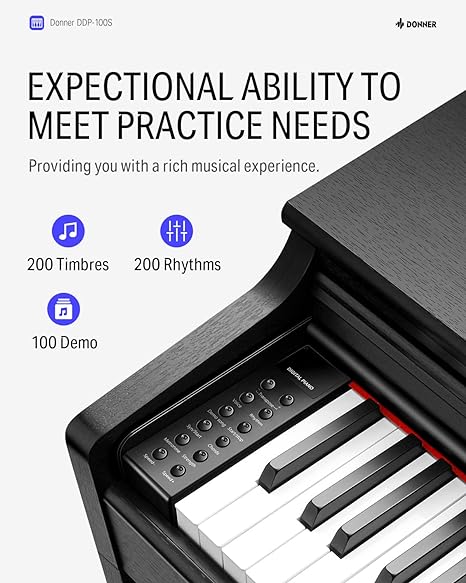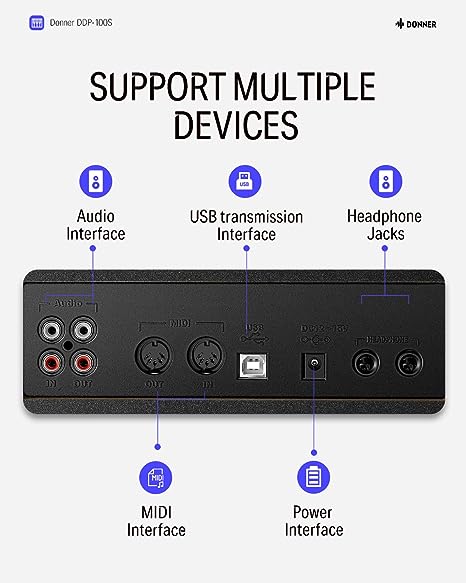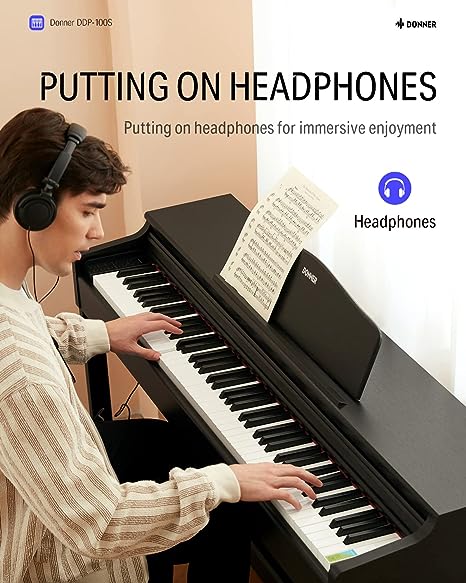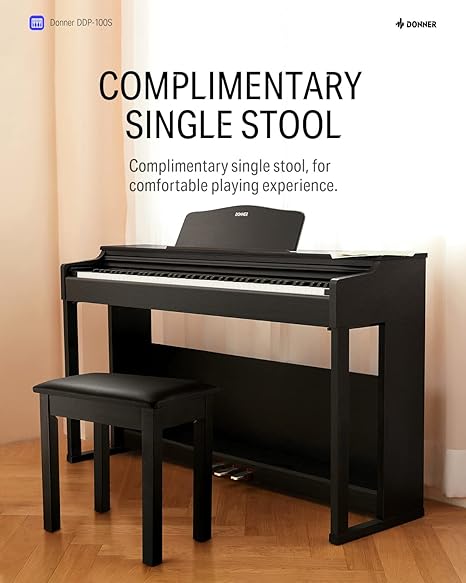Best Digital Piano Beginners
Learning to play the piano is an enriching experience that requires dedication, patience, and the right equipment. While many people may assume that they need a traditional acoustic piano to learn the instrument, digital pianos have become an increasingly popular option, especially for beginners.
Digital pianos offer many advantages over their acoustic counterparts. They are generally more affordable, take up less space, and can be easily moved around. They also offer a variety of sounds and settings that allow for customization and versatility. Additionally, they have features like volume control and the ability to practice with headphones, making them a more practical choice for those living in apartments or with roommates.
However, with so many options on the market, it can be overwhelming to choose the right digital piano for a beginner. In this comprehensive guide, we will explore the key features and factors to consider when selecting the best digital piano for beginners. Whether you are a parent looking to purchase a piano for your child or an adult starting your piano journey, this guide will provide you with all the information you need to make an informed decision. So, let’s dive in!


Best Digital Piano Beginners
1. Williams Legato 88-key Digital Piano
The Williams Legato 88-key digital piano is an excellent option for beginner pianists who are looking for a budget-friendly instrument. Its design is simple and straightforward, making it easy to use and understand for those who are just starting to learn the instrument.
One of the standout features of the Williams Legato is its 88 full-sized, semi-weighted keys. These keys provide a realistic feel and response that is similar to an acoustic piano, which is essential for beginners who are developing proper technique and finger strength. The semi-weighted keys provide a balance between the touch sensitivity of a traditional piano and the ease of playing that comes with a digital piano.
The Legato also offers five built-in voices, including piano, electric piano, organ, synth, and bass. These voices are designed to provide a range of sounds that can help beginners to develop their musicality and explore different genres of music. Additionally, the piano voice is modeled after a traditional grand piano, providing an authentic sound that will inspire and motivate learners.
2. Unlocking the Wonders of Yamaha P115 88-Key Weighted Action Best Digital Piano Beginners
The Yamaha P115 88-key Weighted Action Digital Piano is a versatile and high-quality instrument that is designed to meet the needs of both beginner and intermediate players. This digital piano is one of the most popular models from Yamaha’s P series, which is known for its excellent sound quality, realistic touch, and durability.
One of the standout features of the Yamaha P115 is its graded hammer standard (GHS) keyboard. This keyboard is designed to provide a realistic touch and feel that is similar to a traditional acoustic piano. The keys are heavier in the lower register and lighter in the upper register, just like a traditional piano, making it easier for beginners to develop proper technique and finger strength. Additionally, the GHS keyboard is also sensitive to touch, allowing players to express their musicality and play with dynamics.
The Yamaha P115 also offers a range of built-in voices, with 14 high-quality voices in total. These include realistic piano sounds, as well as electric pianos, organs, strings, and more. The piano sound is particularly impressive, with Yamaha’s Pure CF Sound Engine technology providing an authentic and expressive sound that captures the nuances of a traditional grand piano. Additionally, the P115 also has a built-in 2-track MIDI recorder, allowing players to record and playback their performances.
3. Yamaha P45 88-key Weighted Action Digital Piano
The Yamaha P45 88-key Weighted Action Digital Piano is a popular and affordable option for those who want to learn to play the piano or practice at home. This digital piano is part of Yamaha’s P series, which is known for its excellent sound quality and realistic touch.
One of the key features of the Yamaha P45 is its weighted hammer action keyboard. This keyboard is designed to replicate the feel and touch of an acoustic piano, with the keys being heavier in the lower register and lighter in the upper register. This realistic touch is essential for beginners who want to develop proper technique and finger strength, as it allows them to practice on an instrument that feels like a traditional piano.
The Yamaha P45 also features Advanced Wave Memory (AWM) sound technology, which provides a high-quality and authentic sound. The piano sound is particularly impressive, with Yamaha’s AWM Stereo Sampling technology capturing the nuances of a traditional grand piano. The P45 also features 10 different voices, including pianos, electric pianos, organs, and strings, providing a range of options for players to explore.
4. Casio Privia Px160bk 88-key Full-size Digital Piano
The Casio Privia Px160bk 88-key Full-size Digital Piano is a high-quality instrument that is designed to provide a realistic playing experience and excellent sound quality for both beginners and intermediate players. This digital piano is one of the most popular models from Casio’s Privia series, which is known for its impressive sound quality and realistic touch.
One of the standout features of the Casio Privia Px160bk is its Tri-Sensor Scaled Hammer Action II keyboard. This keyboard is designed to provide a realistic playing experience that closely mimics the touch and feel of a traditional acoustic piano. The keys are weighted and graded, meaning that the lower keys are heavier than the higher keys, just like a real piano. The Tri-Sensor Scaled Hammer Action II keyboard also includes three sensors per key, which allows for more accurate and expressive playing.
The Casio Privia Px160bk also features Casio’s AiR (Acoustic and Intelligent Resonator) sound engine, which is designed to provide an authentic and expressive sound. This technology uses advanced digital processing to simulate the sound and resonance of a traditional acoustic piano, resulting in a rich and detailed sound that is sure to impress even the most discerning pianists. The Px160bk also includes a range of different voices, including piano, electric piano, strings, and more.
Yamaha P Series P105b 88-key Digital Piano
The Yamaha P Series P105b 88-key Digital Piano is a versatile and portable instrument designed to provide a high-quality playing experience for both beginners and intermediate players. One of the standout features of this digital piano is its Graded Hammer Standard (GHS) keyboard, which is designed to replicate the feel and touch of a traditional acoustic piano. The keys are weighted and graded, meaning that the lower keys are heavier than the higher keys, providing a realistic playing experience that closely mimics that of an acoustic piano.
Another key feature of the Yamaha P105b is its Advanced Wave Memory (AWM) Stereo Sampling technology, which is designed to provide a rich and detailed sound. This technology uses advanced digital processing to sample the sound of a traditional acoustic piano, resulting in a sound that is incredibly authentic and expressive. The P105b also includes a range of different voices, including electric pianos, organs, and strings, allowing players to experiment with different sounds and styles.
The Yamaha P105b also includes a range of features that make it a practical and versatile choice for a range of musical settings. For example, it has a built-in metronome and a range of different rhythms, making it easy for players to practice and perform with a range of different styles and tempos. It also has a USB port, allowing players to connect the instrument to a computer and use it with a range of different software programs and digital audio workstations.

Keyboard or a Piano?
When it comes to learning to play a musical instrument, one of the most common questions is whether to start with a keyboard or a piano. While both instruments share similarities, there are also some significant differences that can impact your playing experience.
Firstly, it’s important to understand that a piano is a traditional acoustic instrument that uses hammers to strike strings, producing a rich and resonant sound. Keyboards, on the other hand, use electronic sound synthesis to replicate a range of different sounds and tones. While some keyboards are designed to mimic the sound and feel of a piano, they can never truly replicate the full range and depth of an acoustic instrument.
One of the main benefits of a keyboard is that they are generally more affordable and portable than pianos. They are also usually smaller and lighter, making them easier to transport and set up in different locations. This makes them a popular choice for beginners who are just starting out and may not have the space or budget for a traditional piano.
However, it’s important to note that keyboards can also have some limitations when it comes to playing technique and expression. Keyboards usually have lighter and more shallow keys compared to a piano, which can make it harder to develop proper finger strength and technique. Additionally, the lack of a traditional soundboard and hammers means that there may be limitations in terms of the dynamic range and tone color that can be achieved.
The Importance of the 88 Key Rule in Choosing the Right Piano
The 88 key rule is a principle that applies to pianos, keyboards, and digital pianos. It states that a full-size piano keyboard should have 88 keys in order to provide the full range of notes and allow for optimal playing technique.
This rule dates back to the 1880s when piano makers began to standardize the keyboard size. Before this, different manufacturers would create pianos with varying numbers of keys, making it difficult for musicians to switch between instruments. However, by settling on 88 keys, it became easier for players to transition between pianos and maintain consistency in their playing.
The 88 key rule applies not just to traditional acoustic pianos but also to digital pianos and keyboards. While some keyboards may have fewer than 88 keys, they are often smaller and designed for specific uses such as travel or performance. However, for beginners and serious pianists alike, a full-size keyboard with 88 keys is essential for proper technique and playing ability.
The 88 key rule is important because it provides the full range of notes that a player needs to express themselves musically. This range includes 52 white keys and 36 black keys, covering seven octaves plus a minor third. With this range, a player can create a wide range of tones, dynamics, and expressions.



Extra Tips for Beginner Digital Piano Buyers
If you’re a beginner looking to buy a digital piano, there are a few extra tips that can help you make the best decision. In addition to setting a budget and considering the factors that can impact the cost of a piano, here are some additional tips to keep in mind.
Firstly, look for a piano with a variety of sounds and settings. As a beginner, you’ll want to experiment with different sounds and settings to find the ones that best suit your playing style and preferences. Look for a piano that offers a range of sounds, such as grand piano, electric piano, organ, and strings.
Secondly, consider the size of the piano. While larger pianos may offer more advanced features, they can also take up a lot of space in your home. If you have limited space, look for a compact or portable digital piano that can easily be moved or stored when not in use.
Thirdly, think about the connectivity options of the piano. If you plan on using the piano with other devices, such as a computer or smartphone, look for one that offers USB or Bluetooth connectivity. This will allow you to easily connect the piano to other devices and use it for recording or playing along with music.
Lastly, consider the overall quality of the piano. Look for one that is well-built and offers good sound quality. Check online reviews and try out the piano in person, if possible, to get a feel for the quality and performance.
The Benefits of Touch Sensitive Keys for a Superior User Experience
When shopping for a digital piano or keyboard, one important feature to consider is touch sensitivity. Touch sensitivity refers to the ability of the keys to detect the force of the player’s touch and produce a corresponding volume or tone. While some keyboards and digital pianos may have non-weighted or semi-weighted keys, touch-sensitive keys are always better for a number of reasons.
Firstly, touch-sensitive keys provide a more realistic playing experience. When a pianist plays an acoustic piano, the sound produced depends on the force with which the keys are struck. A touch-sensitive digital piano or keyboard simulates this experience by varying the volume and tone in response to the player’s touch. This allows for a more expressive performance and a greater range of dynamics.
Secondly, touch-sensitive keys can help to develop proper playing technique. As a player progresses and becomes more skilled, they will naturally vary the force with which they play. A keyboard without touch sensitivity can hinder this development, as the player will not receive feedback on their touch. Touch-sensitive keys, on the other hand, allow players to practice and develop a wider range of expression and technique.
Thirdly, touch-sensitive keys allow for greater versatility. With the ability to adjust the force of touch, players can create a variety of tones and sounds. This is particularly important for musicians who play multiple genres of music or who require a wide range of sounds for their performances.
The Importance of Choosing Quality Brands for Your Purchases
When it comes to purchasing a digital piano or keyboard, one of the most important considerations is the brand. It is always recommended to choose a reputable brand that has a proven track record of producing quality instruments. While lesser-known brands may be tempting due to their lower price point, they often come with a higher risk of poor quality and unreliable performance.
Choosing a good brand means that you can have confidence in the quality of the instrument. Good brands typically have a reputation for producing durable and reliable instruments that are built to last. This is particularly important for musicians who plan on using their instrument for years to come, as they will want an instrument that can withstand regular use and transport.
In addition to reliability, good brands often have a wider range of options available. This can include features such as touch sensitivity, a variety of voices and sounds, and built-in recording capabilities. A reputable brand will also offer good customer support and may even have a network of authorized repair centers.
Another benefit of choosing a good brand is that it can help with resale value. If you decide to upgrade or sell your instrument in the future, a well-known brand can increase the value of the instrument and make it more attractive to potential buyers.
Realistic Budget for Your Digital Piano
If you’re in the market for a new digital piano, you may be wondering how much you should spend. With so many options available, it’s easy to get overwhelmed and not know where to start. However, setting a realistic budget is an essential first step in finding the right digital piano for you. In this article, we’ll explore why it’s important to have a budget in mind, what factors can impact the cost of a digital piano, and how to find the best value for your money.
Setting a budget is important for several reasons. Firstly, it helps you narrow down your options. With so many different digital pianos on the market, it can be challenging to know where to start. By having a budget in mind, you can eliminate any options that are outside of your price range and focus on those that are within it.
Secondly, having a budget helps you avoid overspending. It’s easy to get caught up in the excitement of buying a new instrument and spend more than you intended. By setting a budget, you can stay within your means and avoid any financial strain.
Finally, setting a budget allows you to find the best value for your money. Just because a digital piano is expensive doesn’t necessarily mean it’s the best option for you. By considering your budget and comparing options, you can find a piano that offers the features and quality you need without breaking the bank.

Conclusion
In conclusion, buying a digital piano can be a significant investment, and it’s important to make the right choice to ensure that you get the most out of your instrument. As a beginner, it can be overwhelming to navigate the many different options available, but by setting a budget and considering the factors that can impact the cost of a piano, you can narrow down your choices and find the best instrument for your needs.
In addition to these essential factors, there are also some extra tips that can help you make an informed decision. Look for a piano with a variety of sounds and settings, so you can experiment with different styles and find the ones that best suit your preferences. Consider the size of the piano and whether it will fit comfortably in your home, as well as the connectivity options, so you can easily use the piano with other devices and software.
